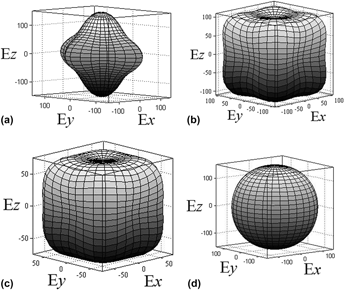Crossref Citations
This article has been cited by the following publications. This list is generated based on data provided by
Crossref.
Liu, Yangzhen
Fu, Hanguang
Li, Wei
Xing, Jiandong
Li, Yefei
and
Zheng, Baochao
2018.
Mechanical properties and chemical bonding of M2B and M2B0.75C0.25(M = Fe, Cr, W, Mo, Mn) compounds.
Journal of Materials Research,
Vol. 33,
Issue. 22,
p.
3665.
Huang, Wenjun
Liu, Fenjun
Liu, Jianbo
and
Tuo, Yaofei
2019.
First-principles study on mechanical properties and electronic structures of Ti–Al intermetallic compounds.
Journal of Materials Research,
Vol. 34,
Issue. 07,
p.
1112.
Taufiq, Ahmad
Wahyuni, Nenny
Saputro, Rosy Eko
Mufti, Nandang
Sunaryono
Hidayat, Arif
Yuliantika, Defi
Hidayat, Nurul
and
Mujamilah
2019.
Investigation of structural, magnetic and antibacterial activities of CrxFe3−xO4 ferrofluids.
Molecular Crystals and Liquid Crystals,
Vol. 694,
Issue. 1,
p.
60.
Millaty Abadiah, Nur
Yuliantika, Defi
Amalia Hariyanto, Yuanita
Eko Saputro, Rosy
Masruroh
Taufiq, Ahmad
and
Soontaranoon, Siriwat
2019.
Nanostructure, Band Gap, and Antibacterial Activity of Spinel Fe2MO4/OO Magnetic Fluids.
IOP Conference Series: Earth and Environmental Science,
Vol. 276,
Issue. 1,
p.
012064.
Wang, Zaihong
Chen, Qingyun
Shih, Kaimin
Liao, Changzhong
Wang, Lielin
Xie, Hua
and
Luo, Yantao
2019.
Uranium(IV) incorporation into inverse spinel magnetite ($$\hbox {FeFe}_{2}\hbox {O}_{4}$$): A charge-balanced substitution case analysis.
Pramana,
Vol. 93,
Issue. 3,
Amelia, T
Saputro, R E
Hidayat, N
Taufiq, A
Diantoro, M
Sunaryono, S
Mufti, N
and
Hidayat, A
2020.
Synthesis and structural characterization of iron chromite nanoparticles: A preliminary study.
Journal of Physics: Conference Series,
Vol. 1595,
Issue. 1,
p.
012027.
Molinari, C.
Conte, S.
Zanelli, C.
Ardit, M.
Cruciani, G.
and
Dondi, M.
2020.
Ceramic pigments and dyes beyond the inkjet revolution: From technological requirements to constraints in colorant design.
Ceramics International,
Vol. 46,
Issue. 14,
p.
21839.
Pillai, Rishi
Pearson, Samuel
Gussev, Maxim N.
Watkins, Thomas R.
and
Pint, Bruce A.
2021.
Quantifying adherence of oxide scales on steels exposed to high temperature and pressure steam.
Materials and Corrosion,
Vol. 72,
Issue. 8,
p.
1315.
Serles, Peter
Arif, Taib
Puthirath, Anand B.
Yadav, Shwetank
Wang, Guorui
Cui, Teng
Balan, Aravind Puthirath
Yadav, Thakur Prasad
Thibeorchews, Prasankumar
Chakingal, Nithya
Costin, Gelu
Singh, Chandra Veer
Ajayan, Pulickel M.
and
Filleter, Tobin
2021.
Friction of magnetene, a non–van der Waals 2D material.
Science Advances,
Vol. 7,
Issue. 47,
Rani, Malika
Batool, Kiran
Younus, Ayesha
Shah, Atta Ullah
Mehmood, Arshad
Shafique, Rubia
Khan, Shamim
Murtaza, G.
and
Neffati, R.
2021.
Synthesis and characterisation of nanosized spinel particles of nickel-doped iron chromite.
Philosophical Magazine Letters,
Vol. 101,
Issue. 12,
p.
464.
He, Lin
Dong, Anping
Zhang, Xuan
Du, Dafan
Pan, Yunwei
Zhu, Guoliang
Lu, Yanling
and
Sun, Baode
2021.
Effect of Microstructure Anisotropy on the Spalling Behavior of Oxide Film of Hastelloy X Alloy Fabricated by Selective Laser Melting (Slm) During the Cyclic Oxidation Process.
SSRN Electronic Journal ,
Mun, Jiwon
Kim, Hyeong-Jin
and
Ryu, Ho Jin
2022.
Analysis of fuel performance under normal operation conditions of MicroURANUS: Micro long-life lead-bismuth-cooled fast reactor.
Frontiers in Energy Research,
Vol. 10,
Issue. ,
He, Lin
Dong, Anping
Du, Dafan
Huo, Xuxu
Xiong, Linghua
Zhang, Xuan
Pan, Yunwei
Lu, Yanling
and
Sun, Baode
2022.
Insight into the Anisotropic Spallation Behavior of Oxidation Film During the Cyclic Oxidation Process for Hastelloy X Alloy Fabricated by Laser Powder-Bed Fusion (L-Pbf).
SSRN Electronic Journal ,
He, Lin
Dong, Anping
Du, Dafan
Gao, Yimin
Huo, Xuxu
Xiong, Linghua
Zhang, Xuan
Lu, Yanling
and
Sun, Baode
2023.
The anisotropic oxidation behavior of Hastelloy X alloy fabricated by laser powder-bed fusion (LPBF) during the cyclic oxidation process.
Corrosion Science,
Vol. 217,
Issue. ,
p.
111156.
Ardit, Matteo
Molinari, Chiara
Verucchi, Daniele
Tintorri, Alice
Migliori, Michela
Toschi, Tanya
Conte, Sonia
Zanelli, Chiara
Cruciani, Giuseppe
and
Dondi, Michele
2023.
Microstructure and phase evolution of micronized ceramic colorants from a pilot plant for inks production.
Ceramics International,
Vol. 49,
Issue. 1,
p.
882.
North, Thomas L.
Collins, Gareth S.
Davison, Thomas M.
Muxworthy, Adrian R.
Steele, Sarah C.
and
Fu, Roger R.
2023.
The heterogeneous response of martian meteorite Allan Hills 84001 to planar shock.
Icarus,
Vol. 390,
Issue. ,
p.
115322.
Tian, Wenjun
Zhou, Yunxuan
Deng, Tao
Chen, Tao
Tan, Jun
Chen, Xianhua
and
Pan, Fusheng
2024.
Probing the Structural Stability, Mechanical, Electronic, and Thermodynamic Properties of Mg–Y–Zn Ternary Compounds via First-Principles Calculations.
Acta Metallurgica Sinica (English Letters),
Vol. 37,
Issue. 10,
p.
1703.




